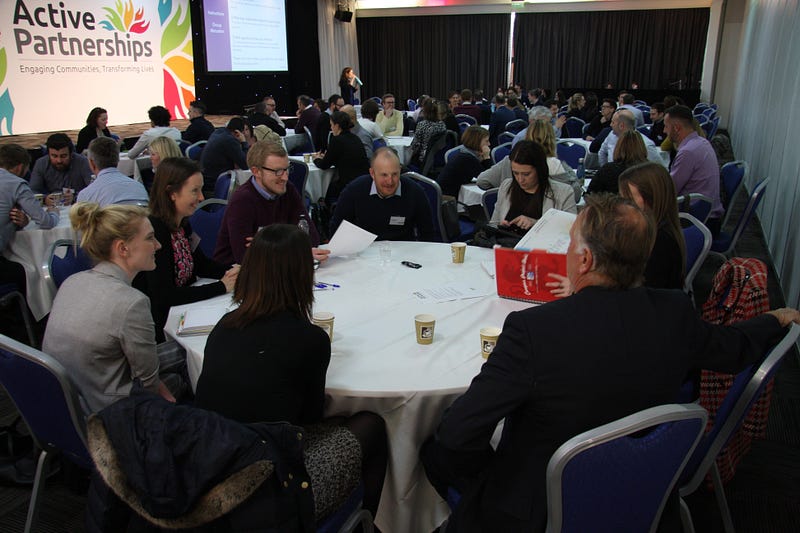Collaborate
|
|
Collaborative leadership — making it everyone’s business
Last month, we facilitated a two-day collaborative leadership convention for 280 staff and board members from the 43 Active Partnerships across England, plus wider partners. Here we reflect on why it was such an ambitious event and what we learned from it.

At Collaborate we see a new approach to leadership as central to bringing about collaborative social change. It’s a core part of the support we provide to places across the UK, from our national Ignite system leadership programme for local authority chief executives, to supporting groups of leaders working on specific issues locally, from perinatal mental health to physical activity. It’s crucial to create space to enable leaders to develop the new mindsets, behaviours, relationships and practical opportunities to work together towards shared goals, and support each other as peers in tackling the challenges that come up along the way.
This new form of leadership is less about hierarchy and control, and more about what we can all do, whatever our role, to contribute to facilitating positive change.
So we were excited to work with the network of Active Partnerships across England to help them think through how they can embed collaborative leadership across their entire workforce: from Board members, to Directors, to project officers, plus Sport England and partners. It’s a real signal of intent that as a network they are investing in this conversation across the entire workforce, not just those in traditional leadership positions.
Their focus on collaborative leadership stems from a realisation that the worryingly low levels of physical activity and stubborn inequalities in some of our communities are challenges that cannot be tackled by a single organisation. This has led to a redefined core purpose for Active Partnerships, as change agents who work collaboratively to create the conditions for an active nation: a clearer focus on inactive and under-represented groups and a shift in emphasis from programme delivery to place-based, whole system collaboration with partners to build bridges between organisations and communities.
The Convention was an important step in this journey. After two days of thought-provoking speakers, interactive workshops that enabled people to practice collaborative leadership behaviours, and opportunities to build networks and learning within and across different teams, we were left inspired by the thoughtfulness of participants and the stories of their collaborative leadership journeys so far. Conversations on practical actions Active Partnership could take included some subtle but important observations about the implications of job titles in creating an unhelpful sense of hierarchy within meetings, how recognition should be shared and distributed, and the importance of organisational values in shaping behaviour.
For us at Collaborate, there were some key takeaways:
- Making it real: the Convention highlighted the value of giving people the time and space to explore what collaborative leadership means in practice — by recognising and valuing examples of collaborative leadership already happening across the network, and exploring how to be intentional about doing more of this by seeing collaboration as part of the work, not an add on.
- Influencing what you can’t control: increasing levels of physical activity involves influencing actors and agendas that often hold more weight and power — from the local authority, to health partners, to the voluntary sector. Active Partnerships talked powerfully about the challenges and the potential of ‘leading from behind’ by bringing conversations about physical activity into existing agendas, and by trying to foster the conditions and model the behaviours for more collaborative approaches across their place.
- Purpose and values: it’s our personal purpose that gives us the resilience and energy to lead change within complex systems. Key topics of discussion were: investing in relationships; identifying shared purpose; and understanding where other people are coming from to build and underpin coalitions for change.
- Peer learning: the power of peer learning shone through. Participants were eager to learn together, and create new ways to share ideas and support each other as peers across the network as a way to build strong and more collaborative approaches.
Original article link: https://collaboratecic.com/collaborative-leadership-making-it-everyones-business-190ae8ccb00b
Home About Us Upcoming Events Reports
![]() @CollaborateIns
@CollaborateIns



.png)